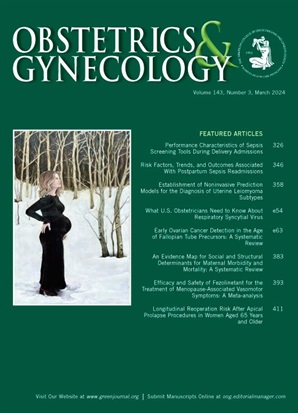Clinical Outcomes of Bilateral Oophorectomy Compared With Ovarian Preservation in Patients With Intravenous Leiomyomatosis Who Underwent Hysterectomy.
IF 4.7
2区 医学
Q1 OBSTETRICS & GYNECOLOGY
引用次数: 0
Abstract
OBJECTIVE Intravenous leiomyomatosis is a rare, histologically benign yet biologically aggressive smooth muscle tumor. Previous studies have indicated that ovarian hormones may play a crucial role in the pathogenesis of intravenous leiomyomatosis. However, the question of whether the deprivation of ovarian estrogen, including bilateral oophorectomy, reduces tumor recurrence in intravenous leiomyomatosis remains unclear. METHODS This retrospective cohort study, conducted across multiple centers in China from August 2003 to July 2023, focused on premenopausal patients with intravenous leiomyomatosis who underwent hysterectomy. Patients were categorized into either the bilateral oophorectomy group or the ovarian preservation group. The study compared disease-free survival (DFS) between these two groups. Univariate and multivariate analyses were employed to identify factors associated with DFS. RESULTS The study included 219 patients, with 132 (60.3%) in the bilateral oophorectomy group and 87 (39.7%) in the ovarian preservation group. Generally, patients in the bilateral oophorectomy group were older, were more likely to have given birth, and had a higher proportion of extrauterine disease compared with those in the ovarian preservation group. Kaplan-Meier curves showed significantly lower recurrence rates in the bilateral oophorectomy group compared with the ovarian preservation group (P=.01). The cumulative recurrence rates at 3 years, 5 years, and 10 years were 0.8%, 2.6%, and 4.0%, respectively, in the bilateral oophorectomy group and 9.0%, 10.3%, and 14.0%, respectively, in the ovarian preservation group. Multivariate analysis for DFS demonstrated that ovarian preservation significantly increased the risk of tumor recurrence (adjusted hazard ratio 0.14, 95% CI, 0.04-0.52, P=.003). CONCLUSION Simultaneous bilateral oophorectomy may reduce the risk of tumor recurrence for premenopausal women diagnosed with intravenous leiomyomatosis who undergo hysterectomy.双侧卵巢切除与保留卵巢在静脉子宫肌瘤切除术患者中的临床效果比较。
目的:静脉平滑肌瘤病是一种罕见的、组织学良性但生物学上具有侵袭性的平滑肌肿瘤。既往研究表明卵巢激素可能在静脉平滑肌瘤病的发病机制中起重要作用。然而,是否剥夺卵巢雌激素,包括双侧卵巢切除术,减少静脉平滑肌瘤病的肿瘤复发的问题仍不清楚。方法本回顾性队列研究于2003年8月至2023年7月在中国多个中心进行,主要研究对象为经子宫切除术的绝经前静脉平滑肌瘤病患者。患者分为双侧卵巢切除组和卵巢保留组。该研究比较了这两组的无病生存(DFS)。采用单因素和多因素分析来确定与DFS相关的因素。结果219例患者,双侧卵巢切除术组132例(60.3%),保留卵巢组87例(39.7%)。一般来说,双侧卵巢切除术组患者年龄较大,生育可能性较大,发生子宫外疾病的比例高于卵巢保留组。Kaplan-Meier曲线显示双侧卵巢切除组复发率明显低于卵巢保留组(P= 0.01)。双侧卵巢切除术组3年、5年、10年累积复发率分别为0.8%、2.6%、4.0%,卵巢保留组分别为9.0%、10.3%、14.0%。DFS的多因素分析显示,卵巢保留显著增加肿瘤复发的风险(校正风险比0.14,95% CI, 0.04-0.52, P= 0.003)。结论经静脉平滑肌瘤病行子宫切除术的绝经前妇女同时行双侧卵巢切除术可降低肿瘤复发的风险。
本文章由计算机程序翻译,如有差异,请以英文原文为准。
求助全文
约1分钟内获得全文
求助全文
来源期刊

Obstetrics and gynecology
医学-妇产科学
CiteScore
11.10
自引率
4.20%
发文量
867
审稿时长
1 months
期刊介绍:
"Obstetrics & Gynecology," affectionately known as "The Green Journal," is the official publication of the American College of Obstetricians and Gynecologists (ACOG). Since its inception in 1953, the journal has been dedicated to advancing the clinical practice of obstetrics and gynecology, as well as related fields. The journal's mission is to promote excellence in these areas by publishing a diverse range of articles that cover translational and clinical topics.
"Obstetrics & Gynecology" provides a platform for the dissemination of evidence-based research, clinical guidelines, and expert opinions that are essential for the continuous improvement of women's health care. The journal's content is designed to inform and educate obstetricians, gynecologists, and other healthcare professionals, ensuring that they stay abreast of the latest developments and best practices in their field.
 求助内容:
求助内容: 应助结果提醒方式:
应助结果提醒方式:


